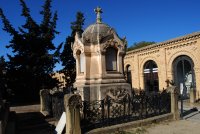1. Acceses and path "A" (West Side)
We start this route outside the main gate of the so-called Ancient Cemetery. Opposite the gate, we see a chapel planned in 1912 by José de Yarza, a rectangular-shape brick building with a bright Neo-Romanesque front and a belfry.

From the outside, we can see the high brick wall which surrounds and isolates the cemetery. We cross the gate and opposite to it we see Costa Path. We walk along it, and, later, along path "A" both to the right (west side) and to the left (east side). We can observe the chapels-crypts placed against the wall projected by Ricardo Magdalena in Neo-Mudejar style, made in brickwork. They also have the same characteristics: access to the crypt from outside and metal enclosure, chapel with a vast glazed opening framed by a round arch. There is an altar inside placed against the wall, in some cases with interesting decorative works and even outstanding sculptures such as the portrait of the philanthropist José Aznárez and the allegorical relieves of Modesty and Charity (chapel 10, 1997) made by Dionisio Lasuén but very badly preserved.
Opposite (chart 2), we can see several solemn pantheons built at the end of the 19th century, made in stone and solidly built without inner space, under which burial crypts are placed. The group is surrounded by an artistic fence made in wrought with stone pillars. The family vault of the Villarroyas´ -made in an eclectic style- can be highlighted by its size and rich funerary symbology. The letter omega, -the last of the Greek alphabet- means bad omen, cold and night; the vases covered with cloth suggests us a pall. The vault of Tomás Family is a beautiful classic construction with fluted-shafted columns and a cornice decorated with cane fascias and acroterias. It can be also emphasized the family vault of the Sierra´s, rounded off with a hemisphere-shaped stone vault. It contains many plant decoration, wreaths, ribbons, garlands, tails, flowers, and classic elements such as acroteria.
Nearby, inside the same area, we find the obelisk in honour of Aragon Field Marshall Mr. Blas de Fournás, who died in 1845. The tomb was built by the City of Zaragoza.
Once again, going along path "A", we come back to the main gate.